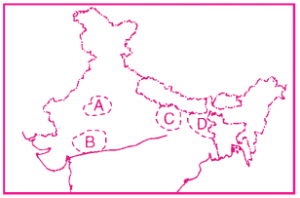1. Mrichchakatikam–Shudraka
2. Buddhacharita–Vasuvandhu
3. Mudrarakshasha–Vishakadatta
4. Harshacharita–Banabhatta
Select the correct answer using the codes given below:
Codes:
(a) 1, 2, 3 and 4
(b) 1, 3 and 4
(c) 1 and 4
(d) 2 and 3
1. Mrichchakatikam–Shudraka
2. Buddhacharita–Vasuvandhu
3. Mudrarakshasha–Vishakadatta
4. Harshacharita–Banabhatta
Select the correct answer using the codes given below:
Codes:
(a) 1, 2, 3 and 4
(b) 1, 3 and 4
(c) 1 and 4
(d) 2 and 3
(a) I and X
(b) I and XI
(c) II and XIII
(d) II and XIV
(a) Buddhism was in the ascendant at that time
(b) they had renounced the policy of war and violence
(c) caste-ridden Hinduism did not attract them
(d) Buddhism provided easier access to Indian society
(a) 601
(b) 300
(c) 330
(d) 407
(a) Chaturvedimangalam
(b) Parishad
(c) Ashtadikgaja
(d) Manigrama
| List-I (Author) | List-II (Text) |
| A. Varahamihira | 1. Prabandha Chintamani |
| B. Vishakhadatta | 2. Mrichchha-Katikam |
| C. Sudraka | 3. Brihat-Samhita |
| D. Bilhana | 4. Devi-Chandraguptam |
| 5. Vikramankadeva-Charita |
Codes:
(a) A – 3; B – 4; C – 5; D – 2
(b) A – 3; B – 4; C – 2; D – 5
(c) A – 5; B – 3; C – 4; D – 1
(d) A – 1; B – 3; C – 5; D – 2
(a) Rupaka
(b) Karshapana
(c) Dinara
(d) Pana
(a) Vajrapani
(b) Manjusri
(c) Padmapani
(d) Maitreya

The places marked A, B, C and D respectively are:
(a) Matsya, Cedi, Kosala, Anga
(b) Surasena, Avanti, Vatsa, Magadha
(c) Matsya, Avanti, Vatsa, Anga
(d) Surasena, Cedi, Kosala, Magadha
(a) Kalsi
(b) Rummindei
(c) Special Kalinga Edict
(d) Maski